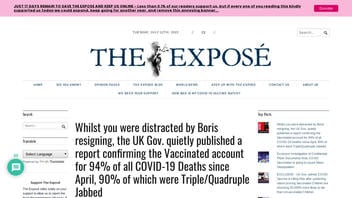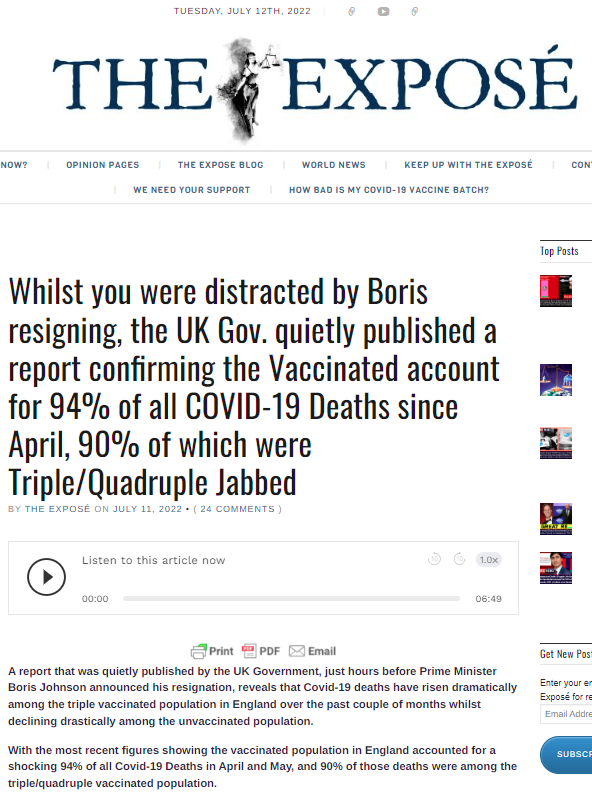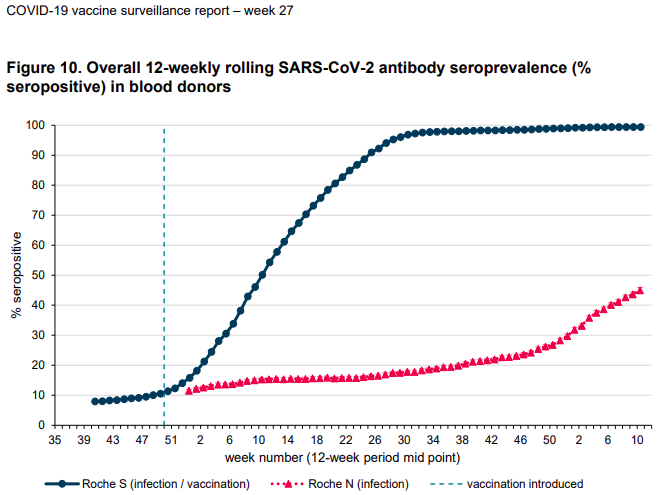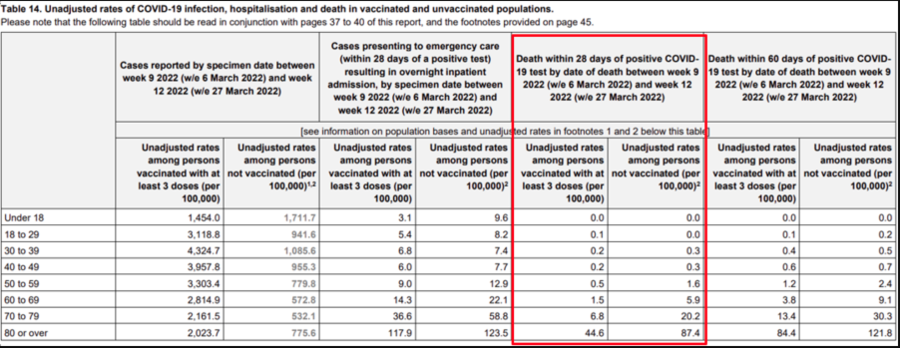Fact Check: High Vaccination Rate Explains Why 94% Of English COVID Deaths Are Among Fully Vaccinated — Numbers Only Part Of Full Story

Do fully vaccinated people account for 94 percent of COVID-19 deaths in England? Yes, that’s true: However, a simple ratio analysis based on that statistic doesn’t fully tell the story. A report that some of the information comes from warns on Page 45 that “Comparing case rates among vaccinated and unvaccinated populations should not be used to estimate vaccine effectiveness against COVID-19 infection.”
Biostatistics experts have explained in related Lead Stories fact checks that those most likely to be vaccinated in the United Kingdom are the elderly, who are also most at risk of serious illness if they suffer a breakthrough infection. Looking at all COVID deaths — instead of comparing like-age patients — muddles the evidence of vaccine effectiveness.
The claim appeared in an article (archived here) published by The Exposé on July 11, 2022, under the title “Whilst you were distracted by Boris resigning, the UK Gov. quietly published a report confirming the Vaccinated account for 94% of all COVID-19 Deaths since April, 90% of which were Triple/Quadruple Jabbed.” It opened:
A report that was quietly published by the UK Government, just hours before Prime Minister Boris Johnson announced his resignation, reveals that Covid-19 deaths have risen dramatically among the triple vaccinated population in England over the past couple of months whilst declining drastically among the unvaccinated population.
With the most recent figures showing the vaccinated population in England accounted for a shocking 94% of all Covid-19 Deaths in April and May, and 90% of those deaths were among the triple/quadruple vaccinated population.
This is what the post looked like on The Exposé website at the time of writing:
(Source: The Exposé screenshot taken on Tue July 12 14:52:16 2022 UTC)
Different reports, different times
Although The Exposé article is a mishmash of reports over a number of months, its data is largely accurate. However, the figures aren’t presented in context and ignore an important footnote from the COVID-19 vaccine surveillance report Week 13 from the U.K. Health Security Agency (HSA), published on March 31, 2022. A notation on Page 44 says:
In the context of very high vaccine coverage in the population, even with a highly effective vaccine, it is expected that a large proportion of cases, hospitalisations and deaths would occur in vaccinated individuals, simply because a larger proportion of the population are vaccinated than unvaccinated and no vaccine is 100% effective. This is especially true because vaccination has been prioritised in individuals who are more susceptible or more at risk of severe disease. Individuals in risk groups may also be more at risk of hospitalisation or death due to non-COVID-19 causes, and thus may be hospitalised or die with COVID-19 rather than because of COVID-19.
A July 13, 2022, email from the HSA provided additional context:
It is not because people who are vaccinated are more likely to die, it is because more people are vaccinated than unvaccinated. There will always be some breakthrough infections leading to death because no vaccine is 100% effective, but a small proportion of a very large (vaccinated) population is sometimes bigger than a larger proportion of a smaller (unvaccinated) population.
The population of England was 74.7 percent fully vaccinated as of July 13, 2022, with 125.9 million doses given, according to the U.K. coronavirus website. That compares to 67 percent of the total U.S. population being fully vaccinated through July 8, 2022, according to the Centers for Disease Control and Prevention (CDC). Page 37 of the UK vaccine surveillance report for week 27, which was published on July 7, 2022, says COVID antibody levels are high:
Overall population weighted (by age group, sex and NHS region) antibody prevalence among blood donors aged 17 years and older in England was 45.0% [due to infection alone – red line below] … and 99.4% [due to infection/vaccination – dark blue line] … for the period 31 January to 27 March (weeks 5 to 12 2022).
This chart from the same report shows the high percentage of blood donors in the population with COVID antibodies:
(Source: COVID-19 vaccine surveillance report Week 27 – Figure 10 screenshot taken on Wed July 13 17:05:12 2022 UTC)
According to the U.K. National Health Service, everyone aged 5 and over can get a first and second dose of the COVID vaccine:
People aged 12 and over who had a severely weakened immune system when they had their first 2 doses, will be offered a 3rd dose and a booster (4th dose).
People aged 75 and over, people who live in care homes for older people, and people aged 12 and over who have a weakened immune system, will be offered a spring booster.
Doing the math
In addition to the HSA, The Exposé article also cites data from the U.K. Office for National Statistics (ONS). Using it, Lead Stories calculated COVID deaths for April and May 2022. Virus-related deaths totaled 4,935 for the timeframe — 288 (6 percent) were unvaccinated, 4,647 (94 percent) were vaccinated and 4,212 (85 percent) were triple vaccinated.
Lead Stories’ figures matched The Exposé’s claim that 94 percent of COVID deaths in England were among those who had received at least one dose of a COVID vaccine. It was a different story for the triple-vaccinated claim of 90 percent, which was 5 points short but was still in the ballpark.
Table 1:
(Source: ONS: Screenshot of Table 1 of the spreadsheet Deaths occurring between 1 January 2021 and 31 May 2022 taken on Wed July 13 18:26:51 2022 UTC)
Circumstances matter
In a July 13, 2022, email to Lead Stories, the ONS said context is important when considering the percentages:
Looking at the proportion of deaths in fully vaccinated without accounting for the vaccination rate is highly misleading.
For instance, if everyone was vaccinated, 100% of people would die vaccinated.
Returning to the HSA report, it also included the following as part of its key results (Page 38) through March 31, 2022:
The rate of hospitalisation within 28 days of a positive COVID-19 test increases with age, and is substantially greater in unvaccinated individuals compared to vaccinated individuals.
The rate of death within 28 days or within 60 days of a positive COVID-19 test increases with age, and again is substantially greater in unvaccinated individuals compared to fully vaccinated individuals.
Also from the July 13, 2022, email to Lead Stories, the HSA said:
The important statistic here is the rate of death for each group. Percentage wise, the proportion of deaths remains higher in those who are unvaccinated, compared to those who are vaccinated. Table 14 on page 45 of the report shows the rate of death per 100,000 people, split by age. As you can see, in every age group (barring in this report the very low numbers in the 18-29 age group under the ‘deaths within 28-days’ column), the rate of death is higher in those who are unvaccinated, compared to those who are vaccinated with at least three doses.
This is the deaths section from Table 14 in the report:
(Source: COVID-19 vaccine surveillance report Week 13 screenshot taken on Wed 13 20:26:57 2022 UTC)
The executive summary of the report says the safety of COVID vaccines is continuously being monitored by the U.K. Medicines and Healthcare Regulatory Agency:
They conclude that overall, the benefits of COVID-19 vaccines outweigh any potential risks
Earlier Lead Stories fact checks looked at similar claims by The Exposé and found them to be misleading (here, here, here and here).






